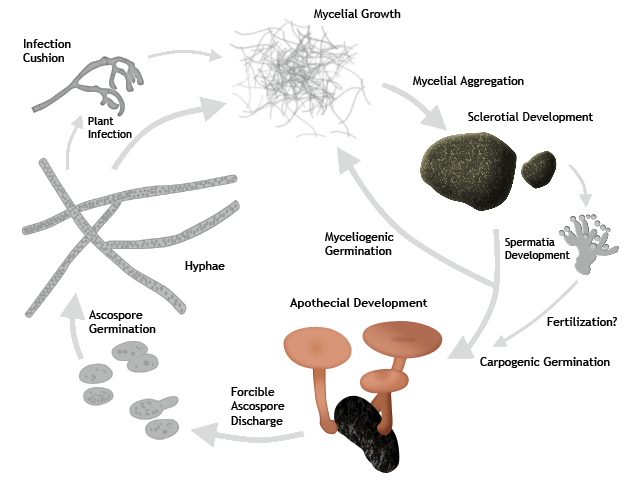Developmental Life Cycle of S. sclerotiorum
Click on a stage in the life cycle to learn more, and see movies and pictures.

- Plant Infection
- Sclerotinia produces complex appressoria commonly called infection cushions. Usually derived from hyphae rather than from germ tubes, the complexity of these structures varies depending on the nutrient status of the fungus and “hardness” of the surface on which they are formed. Penetration of the plant surface occurs from multiple tips of the infection cushion.
- Mycelial Aggregation and Sclerotial Development
- One of the most conspicuous feature of S. sclerotiurum when grown in culture is the production of sclerotia. Sclerotia are macroscopic, several mm to several cm in diameter, multihyphal aggregates of hyphae surrounded by a melanized hyphal rind layer. They serve as quiescent survival structures and can germinate myceliogenically in the presence of exogenous nutrients or carpogenically (production of apothecia, the sexual fruiting bodies) after proper environmental conditioning.
- Spermatia Development
- S. sclerotiorum is homothallic, but produces phialospores that may function in fertilization. These phialospores do not germinate in water or in response to nutrients.
- Apothecial Development
- The sexual fruiting body of Sclerotinia is a stipitate apothecium. The upper surface is the spore-bearing surface. Apothecial development begins within the interior of the sclerotium. Undifferentiated stipes carpogenically germinate by pushing trough the sclerotial rind layer. In the presence of suitable light conditions, a stipe differentiates a single disc at the tip.
- Ascospore Germination
- Ascospores are produced following meiosis and forcibly discharged from the apothecial surface. Ascospores can travel great distance on air currents. Germination of ascospores requires water, but ascospores can not infect healthy plant tissues without the presence of exogenous nutrients.
- Hyphae
- Hyphae are multinucleate and grow by polar elongation. Subapical (intercalary) branching is common but dichotomous branching of the tips is also observed.
Updated 29 May 2007 by Jeffrey Rollins.